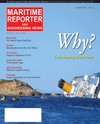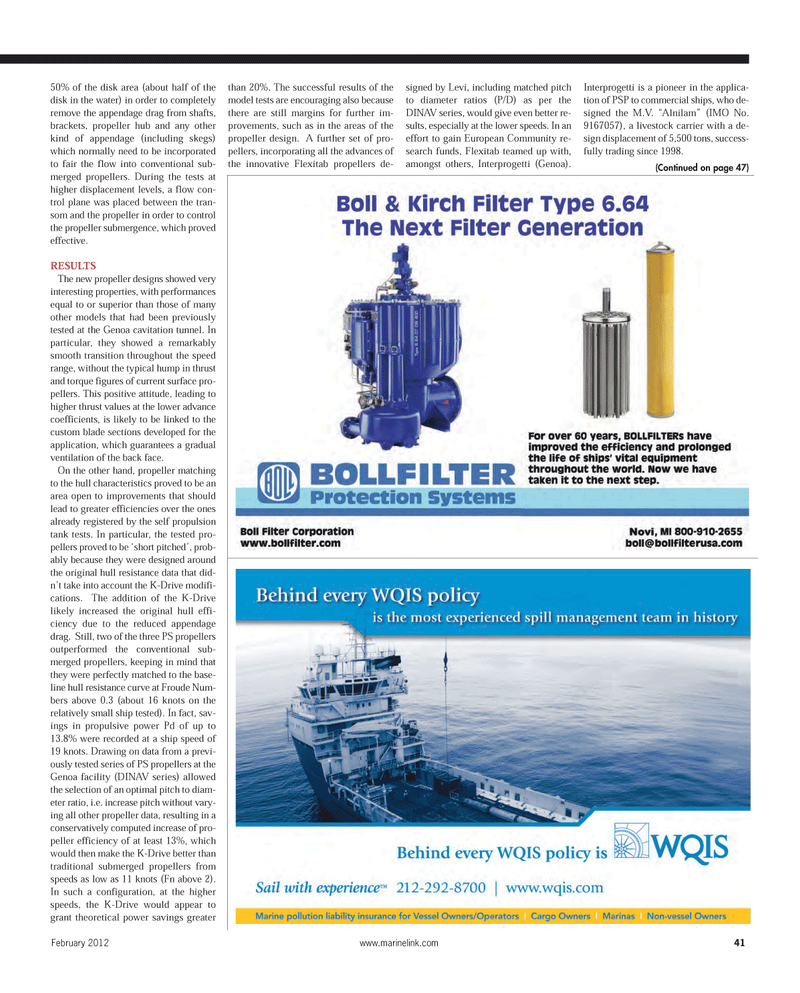
Page 41: of Maritime Reporter Magazine (February 2012)
Cruise Shipping Annual
Read this page in Pdf, Flash or Html5 edition of February 2012 Maritime Reporter Magazine
50% of the disk area (about half of thedisk in the water) in order to completely remove the appendage drag from shafts, brackets, propeller hub and any other kind of appendage (including skegs) which normally need to be incorporatedto fair the flow into conventional sub- merged propellers. During the tests at higher displacement levels, a flow con- trol plane was placed between the tran- som and the propeller in order to controlthe propeller submergence, which proved effective. RESULTS The new propeller designs showed very interesting properties, with performancesequal to or superior than those of manyother models that had been previously tested at the Genoa cavitation tunnel. In particular, they showed a remarkably smooth transition throughout the speedrange, without the typical hump in thrustand torque figures of current surface pro- pellers. This positive attitude, leading to higher thrust values at the lower advance coefficients, is likely to be linked to the custom blade sections developed for the application, which guarantees a gradualventilation of the back face. On the other hand, propeller matchingto the hull characteristics proved to be an area open to improvements that should lead to greater efficiencies over the ones already registered by the self propulsion tank tests. In particular, the tested pro- pellers proved to be ?short pitched?, prob- ably because they were designed around the original hull resistance data that did-n?t take into account the K-Drive modifi- cations. The addition of the K-Drive likely increased the original hull effi- ciency due to the reduced appendage drag. Still, two of the three PS propellers outperformed the conventional sub- merged propellers, keeping in mind that they were perfectly matched to the base- line hull resistance curve at Froude Num- bers above 0.3 (about 16 knots on the relatively small ship tested). In fact, sav- ings in propulsive power Pd of up to 13.8% were recorded at a ship speed of19 knots. Drawing on data from a previ- ously tested series of PS propellers at theGenoa facility (DINAV series) allowed the selection of an optimal pitch to diam-eter ratio, i.e. increase pitch without vary- ing all other propeller data, resulting in aconservatively computed increase of pro- peller efficiency of at least 13%, which would then make the K-Drive better than traditional submerged propellers from speeds as low as 11 knots (Fn above 2). In such a configuration, at the higher speeds, the K-Drive would appear to grant theoretical power savings greater than 20%. The successful results of the model tests are encouraging also becausethere are still margins for further im- provements, such as in the areas of the propeller design. A further set of pro- pellers, incorporating all the advances of the innovative Flexitab propellers de- signed by Levi, including matched pitch to diameter ratios (P/D) as per theDINAV series, would give even better re- sults, especially at the lower speeds. In an effort to gain European Community re- search funds, Flexitab teamed up with, amongst others, Interprogetti (Genoa).Interprogetti is a pioneer in the applica-tion of PSP to commercial ships, who de-signed the M.V. ?Alnilam? (IMO No. 9167057), a livestock carrier with a de- sign displacement of 5,500 tons, success-fully trading since 1998. February 2012www.marinelink.com 41(Continued on page 47)MR Feb.12 # 5 (34-41):MR Template 2/7/2012 10:42 AM Page 41

 40
40

 42
42
